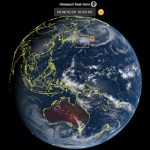 November 26, 2019 10:49 am
Published by Climate Extremes
November 26, 2019 10:49 am
Published by Climate Extremes
Turning on a magnetic field may make fluids that conduct electricity behave more like honey than like water. This discovery may help explain a mystery of Jupiter's zonal winds, the alternating east-west jet streams, seen in photographs as colourful stripes.
 November 26, 2019 10:26 am
Published by Climate Extremes
November 26, 2019 10:26 am
Published by Climate Extremes
Solar heating of surface waters in the tropical Indian and Pacific oceans, along with turbulent mixing that moves this heat into the colder deep-reaching Atlantic meridional overturning circulation, play a crucial role in shaping oceanic heat transport pathways
 November 26, 2019 9:57 am
Published by Climate Extremes
November 26, 2019 9:57 am
Published by Climate Extremes
In this paper, CLEX researchers considered the steady-state response of the atmosphere to an imposed large-scale flow. They found that under these steady-state conditions, humidity increases with the precipitation rate, while the lapse rate (rate of decrease of temperature with height) increases.
 November 25, 2019 2:34 pm
Published by Climate Extremes
November 25, 2019 2:34 pm
Published by Climate Extremes
CLEX researchers investigate the physics of the Antarctic Circumpolar Current to understand why increased wind stress doesn't lead to a more powerful current. It turns out the ocean floor plays a key role.
 November 25, 2019 1:15 pm
Published by Climate Extremes
November 25, 2019 1:15 pm
Published by Climate Extremes
To better understand the biases and ultimately improve the quality of our climate records, CLEX researches and their collaborators undertook in situ measurements using the NOAA Physical Sciences Division flux system during the Clouds, Aerosols, Precipitation, Radiation, and Atmospheric Composition over the Southern Ocean (CAPRICORN) experiment in 2016.
 November 25, 2019 12:46 pm
Published by Climate Extremes
November 25, 2019 12:46 pm
Published by Climate Extremes
This study found in CMIP5 models that are able to simulate both types of events, that convective extremes do not always coincide with warm extremes. The disassociation becomes more distinct under greenhouse warming with higher occurrences of convective extremes than warm extremes.
 November 25, 2019 12:15 pm
Published by Climate Extremes
November 25, 2019 12:15 pm
Published by Climate Extremes
This paper investigates the annual cycle in cloud and rainfall measurements over the western equatorial Indian Ocean. While there is a single period of strong rainfall over the region during December-January each year, there are two periods of increased high-top clouds associated with convection.
 November 6, 2019 11:20 am
Published by Climate Extremes
November 6, 2019 11:20 am
Published by Climate Extremes
CLEX researchers and colleagues found the Aridity Index was too simplistic to capture the many aspects that define landscape aridity, including the amount of rainfall, water resources and vegetation productivity, and is a poor indicator of future aridity changes.
 October 25, 2019 12:23 pm
Published by Climate Extremes
October 25, 2019 12:23 pm
Published by Climate Extremes
With projected increases in temperature in the future, the amount of water vapour that can be held at saturation – before it condenses into clouds, dew or water film – increases exponentially. As this deficit increases plants tend to close their stomata, which reduces water fluxes into the boundary layer. Do models currently capture the observed leaf-level response to increasing vapour pressure deficit? What about at very high levels of this deficit?
 October 25, 2019 11:31 am
Published by Climate Extremes
October 25, 2019 11:31 am
Published by Climate Extremes
While the data from Himiwari-8 provides very useful data on clouds at relatively high resolution, researchers need to know if it produced any biases, particularly around cloud-top height and cloud-top temperature, whose roles are critical in shaping Earth’s climate. CLEX researchers and Australian colleagues compared the Himawari-8 data for both of these measures with existing datasets.










